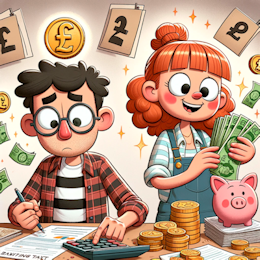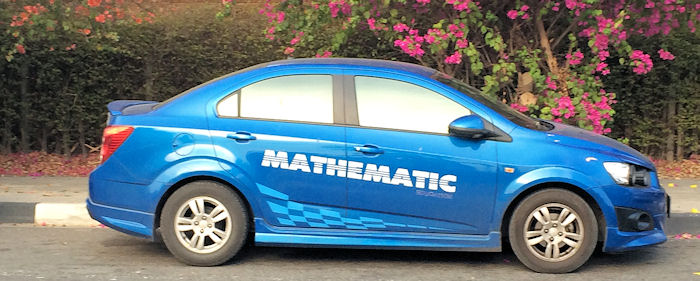
 |
Exam-Style Questions.Problems adapted from questions set for previous Mathematics exams. |
1. | GCSE Higher |
(a) In an election, David Linewhip gained 27 552 votes out of a total of 43 715 votes. Write 27 552 as a percentage of 43 715 giving your answer to the nearest integer.
(b) Goodtrip Travel increases the cost of a holiday by 8%. The holiday originally cost £1245. Find the new cost of the holiday.
2. | GCSE Higher |
In 2009 the price of a Big Mac was £2.29.
In 2013 the price of a Big Mac had risen to £2.69.
(a) Work out the percentage increase in the price of this snack over the four years.
(b) Express the price in 2009 as a percentage of the 2013 price.
(c) By what percentage must the 2013 price be discounted to equal the 2009 price?
3. | GCSE Higher |
Davy Browning buys a premium skateboard.
He gets a discount of 15% off the normal price.
Davy pays £170 for the skateboard.
(a) Work out the normal price of the skateboard.

Saj invests £8000 in a savings account.
The savings account pays compound interest at a rate of 1.8% for the first year then 1.2% for each extra year.
(b) Work out the value of Saj’s investment at the end of 4 years.
4. | GCSE Higher |
(a) Davy Browning earns £54000 per year before paying tax.
 He pays tax on his earnings at a rate of 18%.
He pays tax on his earnings at a rate of 18%.
Calculate the amount Davy has after paying tax.
(b) Patty O’Dawes earns £57810 per year after paying tax at a rate of 18%.
Calculate the amount that Patty earns before paying tax.
(c) Davy opens a savings account with £2500.
The account pays 2.4% per year simple interest.
Calculate the amount in Davy’s account at the end of 5 years.
(d) Patty opens a savings account with £500 at the same time ad Davy.
The account pays 2.1% per year compound interest.
Patty pays another £500 into her account on the same day every year.
Find who has the greater amount in their account at the end of 5 years.
5. | GCSE Higher |
(a) Audrey, Seymore and Mr Mushnic share potted plants in the ratio Audrey : Seymore : Mr Mushnic = 3 : 4 : 7. Seymore receives 12 plants. Calculate the total number of plants shared.

(b) In a sale, a plant shop reduces all prices by 15%.
(i) Crystal buys a cactus which has an original price of £8.60. Calculate how much Crystal pays for the cactus.
(ii) Ronette pays £39 for a hanging basket. Calculate the original price of the hanging basket.
(c) Orin invests some money. The rate of interest for the first year is 3.5%. At the end of the second year the overall percentage increase of Orin’s investment is 6.6%. Find the rate of interest for the second year to the nearest whole number.
(d) A radioactive substance decays at an exponential rate of 4% per day. The initial mass is 360g.
(i) Find the mass at the end of 9 days.
(ii) Find how many more whole days, after day 9, it takes for the mass to reduce to less than 200g.
6. | GCSE Higher |
The value of a new car is £22 000.
The value of the car decreases by 30% in the first year then 10% in each of the next 5 years.
Work out the value of the car after 6 years.
7. | GCSE Higher |
Windthrup bought a car for £9500 which depreciated by 6% in the first year and 3.5% in the second year.
a) Windthrup thinks that in two years his car depreciated by 9.5% over the two years. Show, with any necessary calculations, that Winthrup is wrong.
b) Windthrup's car depreciates by \(x%\) during the third year. At the end of the three years the car is worth £8190. Find the value of \(x\) to three significant figures.

8. | GCSE Higher |
Zoe invests £5000 in an account for one year. At the end of the year, interest is added to her account.
Zoe pays tax on this interest at a rate of 25%. After the tax has been taken off she received £25.40 interest.
Work out the percentage interest rate for the account.
9. | GCSE Higher |
Montague invests £7000 for six years in a bank offering compound interest at \(x%\) per annum.
The investment is worth £7654.10 at the end of the six years.
Find the value of \(x\).
10. | GCSE Higher |
John times how long it takes him to run around Hazelnut Park each Friday afternoon. The last three weeks his times, rounded to the nearest minute are \(p, q \; \text{and} \; r\).
He notices that \(q\) is 5% more than \(p\) and \(r\) is 5% less than \(q\).
Indicate which of the following statements are true:
(a) \( r \lt p \) and \( r \lt q \)
(b) \( r \gt p \) and \( r \gt q \)
(c) \( r = p \) and \( r \lt q \)
(d) \( p \gt q \) and \( p = r \)
(e) \( p =q \) and \( p \gt r \)
If you would like space on the right of the question to write out the solution try this Thinning Feature. It will collapse the text into the left half of your screen but large diagrams will remain unchanged.
The exam-style questions appearing on this site are based on those set in previous examinations (or sample assessment papers for future examinations) by the major examination boards. The wording, diagrams and figures used in these questions have been changed from the originals so that students can have fresh, relevant problem solving practice even if they have previously worked through the related exam paper.
The solutions to the questions on this website are only available to those who have a Transum Subscription.
Exam-Style Questions Main Page
To search the entire Transum website use the search box in the grey area below.
Do you have any comments about these exam-style questions? It is always useful to receive feedback and helps make this free resource even more useful for those learning Mathematics anywhere in the world. Click here to enter your comments.